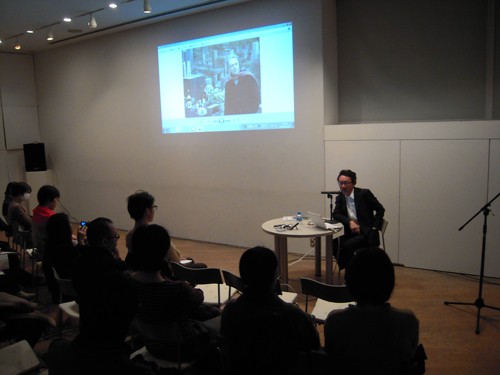Chihiro Minato is a photographer as well as a prolific writer of criticism and research. He received the 31st Ina Nobua Award for his exhibition of photographs Chromatic Citizen and the 1997 Suntory Prize for Social Sciences and Humanities in the category of criticism for his book Sosaku to Soki (the power of creation and reminiscence). He was the commissioner of the Japan Pavilion at the 2007 Venice Biennale and has written reviews of Pedro Costa’s movies. A very short summary of his talk is given below.

The Hara Museum is distinguished by having originally been a private residence. In planning this exhibition, Pedro Costa was attracted to its quality as ″lived in space.″ The artists included in the list of works a quote by Lao Tse about space: ″Walls with windows and doors form the house, but the empty space within it is the essence of the house.″ From this, one might think the exhibition title, MU, also arose from the idea that empty space within a building equals a void.
Much of the attraction of Rui Chafes’ sculpture lies in their unnameable shapes. Also, each work has an intriguing title. The titles have no direct relationship with the shapes, but I believe they provide a clue to deciphering their meanings. Another thing, the sculptures are made of iron, and yet it is hard to tell if they are heavy or light just by looking at them. One piece which looks like a steel wing suspended from the ceiling is entitled Mais leve do que o nada (lighter than nothingness), which I think is a great title.
I often go to Pedro Costa’s movies and write reviews of them. Those of you who have seen his movies are familiar with the black man Ventura who appears in this exhibition. I think it is important to know that he represents the migrant workers from the islands of Cape Verde who live in the slums of Lisbon. For the sake of urban renewal, these slums are being demolished at a fast rate. In the movie Collosal Youth, Ventura visits an art museum which he helped build as a worker at the construction site, but he is asked to leave. It is a metaphorical act of exclusion. The people who support society by doing the work of building homes are themselves not permitted to enter those homes or to own one. In today’s society, the fact is people are parodoxically excluded from the very society they helped create. In another gallery, a close-up of Ventura standing proudly is projected on the wall as he sings a song that recalls his home in Cape Verde. Though his message is not loudly proclaimed, in this installation I believe we can sense Pedro Costa’s concern towards the contradictions within society.
It is said that Pedro Costa and Rui Chafes chose the word MU for the title of the exhibition because of the character inscribed on the headstone of Yasuhiro Ozu. There is no name, just the single character mu. One might say it is no longer a headstone, but a work of sculpture. It seems natural for both artists to ponder the nature of the void as they quote Lao Tse, and to be inspired by the word mu on the headstone.
On January 30, 19:00 – 20:30 at The Hall at the Hara Museum of Contemporary Art
